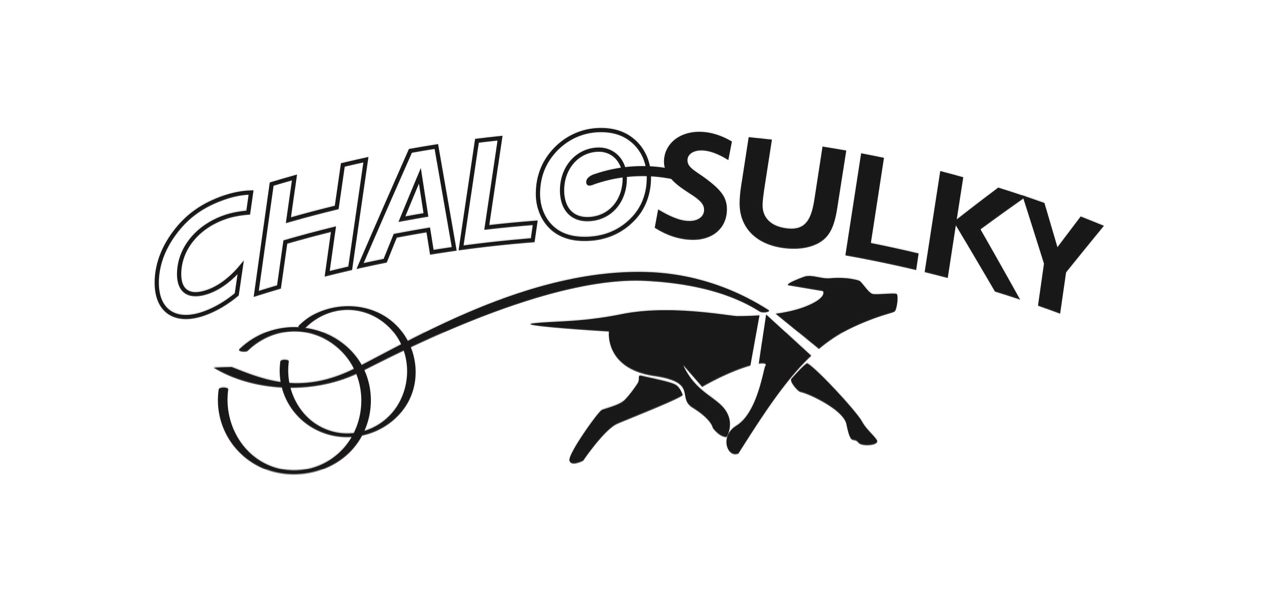In 1994 I bought a Rottweiler puppy. He was a black puppy with red margins. I named him Rubromarginata. Rubro was my dream dog… smart, strong, sweet. I had to create a worthy life for him. How to do that?
First Idea. Teach Rubro to pull. I bought roller blades. Rubro pulled me at a nice trot 2.8 miles around Green Lake in Seattle, Washington. How cool! What fun! One day Rubro chased Canadian geese off the pavement and into the Lake. Aha! Roller blades can’t stop a Rottweiler chasing geese. I needed brakes.
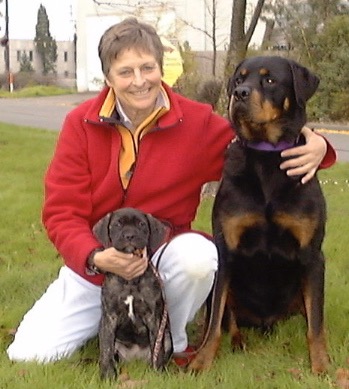
Second Idea. Scooters have brakes. I drove past the thrift store for several weeks hoping to see a scooter. One day I saw a scooter. A child’s scooter… 12″ wheels. I bought it for 99¢. I took it to a bike store to repair the brakes…$99!
Rubro and I scootered on the sidewalks of Seattle and on the walkways at the U.W.campus. Weekends we scootered on trails in the Cascade mountains.
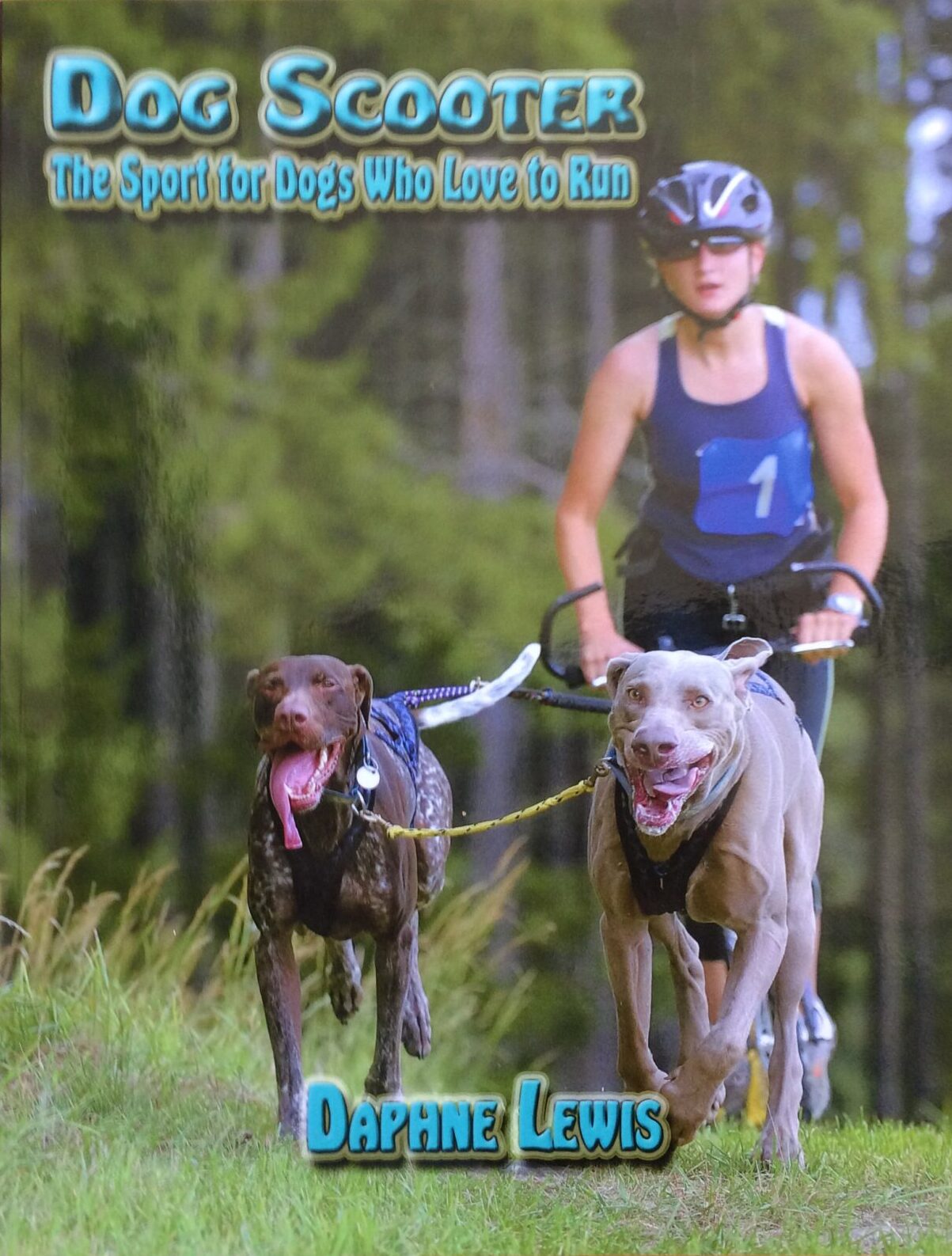
Becky Loveless of Alpine Outfitters designed a harness for Rubro. She named it the urban trails harness. It is short compared to standard mushing harnesses. It can be used as a leash walking harness. When Rubro and I scootered on side walks in Seattle, the urban trails harness let me hold him safely beside the scooter as we waited for the traffic light to change. Rubro behaved so well that I could ride the scooter on the sidewalk and gaze into store windows as we went.
Third idea. If I love riding a scooter pulled by a dog, so would other people, especially mushers. The Northwest Sled Dog Association schedules dryland practice races in fall. Rubro and I and our scooter joined a practice race at a Weyerhaeuser clear-cut. The mushers were surprised to see a Rottweiler and a scooter. They welcomed us and allowed us to race.
Races start one team at a time at two minute intervals. When our start gun sounded, Rubro trotted off pulling me on the scooter. We left the clearing and trotted into the woods. Behind us came a teenager on a three wheel rig pulled by her galloping sled dog. She passed us. Rubro broke into a lope and chased her. Breakthrough! Rubro broke his typical trot! He RAN! We loped past a team of six chinooks standing beside the trail. We finished the race in good time!
Rubro broke the ice for mushing with scooters and for mushing with breeds other than huskies. Scooters allow you to mush even if you have just one or two dogs. They lower the cost of joining the mushing world. Mushing gains participants.
I started a talk group called DogsLovetoRun@yahoogroups.com. Yahoo groups preceded Facebook; was text only; no pictures. In 2005 I wrote a book about how to train a dog to pull a scooter. The cover photo is of a race in the Czech Republic. The dogs are hunting dogs, not sled dogs. Americans were not racing on scooters when I bought my first scooter. Europeans were racing on scooters. Dog scootering in the US became known as Urban Mushing, a more inclusive and more descriptive name.
Fourth idea.Find a better scooter for the new sport. Thanks to Yahoo Groups, a man in Canada told me that he was going to a bicycle manufacturers’ conference in Taiwan and would find a scooter company. He found the Jones Scooter in Australia. It was molded of plastic and had 16″ wheels. I ordered a pallet of six Jones scooters.
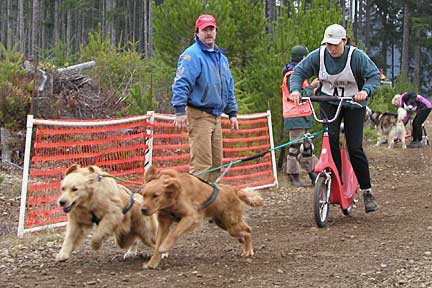
Photo shows a Jones scooter pulled by golden retrievers at the start of a Northwest Sled Dog race. Musher Sue Meinzinger of Summit Assistance Dogs raced her service dogs in training.
Dog Sulkies In 2000, James Walsh of Regal Sulkies in NSW Australia invented, manufactured and sold his dorsal shaft sulky for dogs. The dorsal shaft goes over the dog’s back to attach to a harness. The dorsal shaft is an alternative to the side shafts of traditional wagons, carts and sulkies.
I ordered Walsh’s first model, the Millennium Mini. Ruby and I wore purple in honor of the Regal Sulky. The mini was too wide for my sidewalks. I sold it to a Donna Morton, a musher.
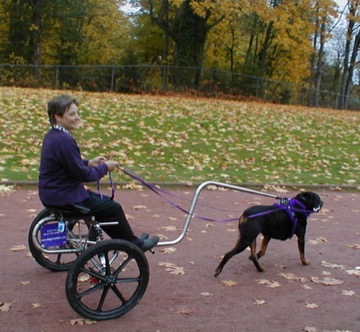
Fifth Idea. Build an American dorsal shaft sulky. Chalo Colina was the machinist for Blue Origin, maker of space ships and founded by Jeff Bezos. Blue Origin was located in an old warehouse near the Seattle harbor. Chalo loved to build crazy bicycles like for clowns to ride. He volunteered to design and build my first dorsal sulky. We met at Blue Origin after working hours usually on Tuesday nights. Chalo bought the materials and did the labor for free.
Soon after completing the original US made dorsal shaft dog sulky, Chalo Colina left Blue Origin and returned home to Austin, Texas. I named my company Chalo Sulky.
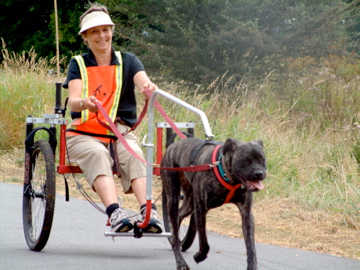
I only have this single photo of the sulky that Chalo built. Our concept was to use stock bicycle parts: suspension forks, 26″ wheels, caliper brakes, a handlebar stem to hold the footrest. A two-cable brake lever controls both brakes so a driver can use one hand to work both brakes. Chalo Colino machined the aluminum fork crown that connects the forks to the frame. The seat was plywood bolted to the frame. You adjust the lift on the shaft tip by sliding backward or forward on the plywood. Tess is wearing her urban trails harness by Alpine Outfitters. I did not yet have a sulky harness.
Tess is a presa canario. Her breeder gave her to me to promote his breed as a working dog as opposed to fighting dog.
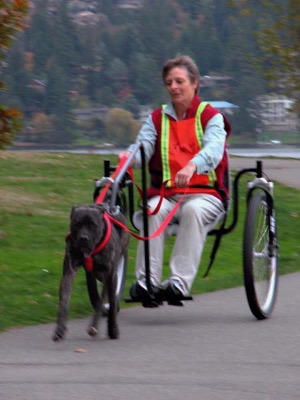
The above early sulky continues the idea of using stock bicycle parts. The top of the frame is bent 90 degrees to hold the shock absorber. There is no machined aluminum fork crown. There is no need for the extra bend at the tip end of the forward shaft. The forward shaft is too long. Extra length causes flexing which causes swaying as the dog speeds up.
Tess, my second dog, looks comfortable in this photo. I ended up rehoming her because she did not like to pull a sulky. Like Chalo Colina, Tess moved to Austin, Texas.
Sixth Idea: Create a new dog sport! Dog driving! Build dog sulkies and harnesses to support the new sport. My daughter suggested that I work with a custom bike builder she knew. Working with him was ideal. He took an interest in improving Chalo’s design. For example, I had a problem with the sulky swaying when Rubro sped up. To understand what was happening, this designer rode his bicycle behind us as we drove along the cliff of West Seattle. He saw that the frame was bending and causing the sulky to sway as we sped up. He added diagonal reinforcing at the bends of the frame.

Like Chalo Colina, he made an aluminum fork crown with three holes, one for the frame and two for the shock absorbers. The frame is shorter and lighter in weight with the three hole fork crown than with the two hole crown. And, it makes a lower arm rest. (We were not able to duplicate this feature in later models because we were unable to disassemble the forks from the crown that they come with.)
The seat is a boat seat used to casting for fish. It bolts to a seat slider used in fishing boats. The slider allows the driver to slide the seat forward or backward to maintain upward lift on the shaft tip. The slider tightens easily by rotating a handle under the seat.
This version used a handle bar for a footrest. Too long; too heavy. Later models used a 12″ aluminum tube and located the stem holding it below the rear shaft, not above it.
My bicycle builder relocated to Europe before my sulky business got going. I worked with two other fabricators in Seattle and one in Tacoma before moving to Georgia. The design changed with each new fabricator. Sometimes because of experience and often because available tools differed from shop to shop.
Other Rigs/Ideas over the years
Two-Person Sulky
I built a sulky for two riders because customers wanted their child or friend to ride with them. After I built a two-person sulky, I realized that balancing the sulky was difficult with two people. The shaft would lift suddenly or come down suddenly as someone got on and off the sulky or leaned forward or back. I only made one two-person sulky. Besides, the sulky was too wide for most sidewalks.
Photos are from the woman who bought it. The collie team is beautiful. When two dogs are pulling with the two-dog hitch, there is little danger of hurting the dog when riders get on and off.
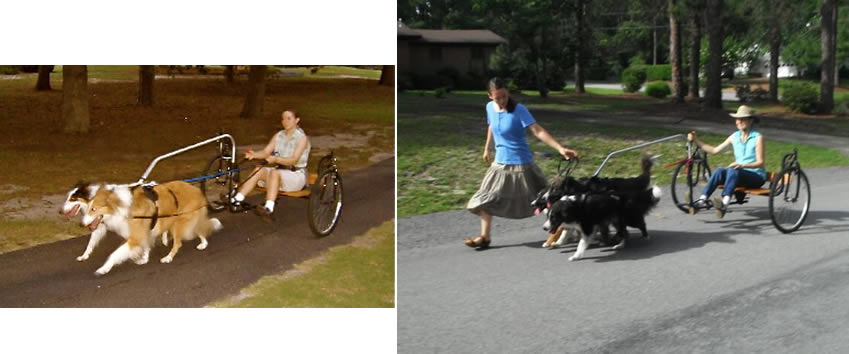
Another way to carry a second person is with a bicycle trailer. We added a trailer hitch to make that easy.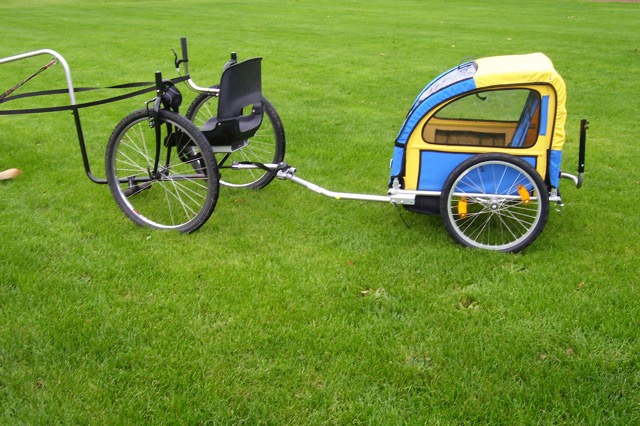
Sulky for Disabled Person

This sulky was custom made in 2010. The father wished to take his adult daughter with him when he and his wife ran or walked the neighborhood. We used a high back seat with a harness to hold her safely. We added straps to the foot rests to secure her feet. The handle allows him to hold the sulky when he runs behind. Sadly, I never heard whether they used the sulky.
The dog modeling the sulky is Brett, a champion Chinook. Brett was given to me when he retired as a stud dog. The breeder said that Brett working for Chalo Sulky would expose the public to the Chinook breed. It was the same consideration as the gift of Tess, the Presa Canario.
Cheaper and Easier to Build
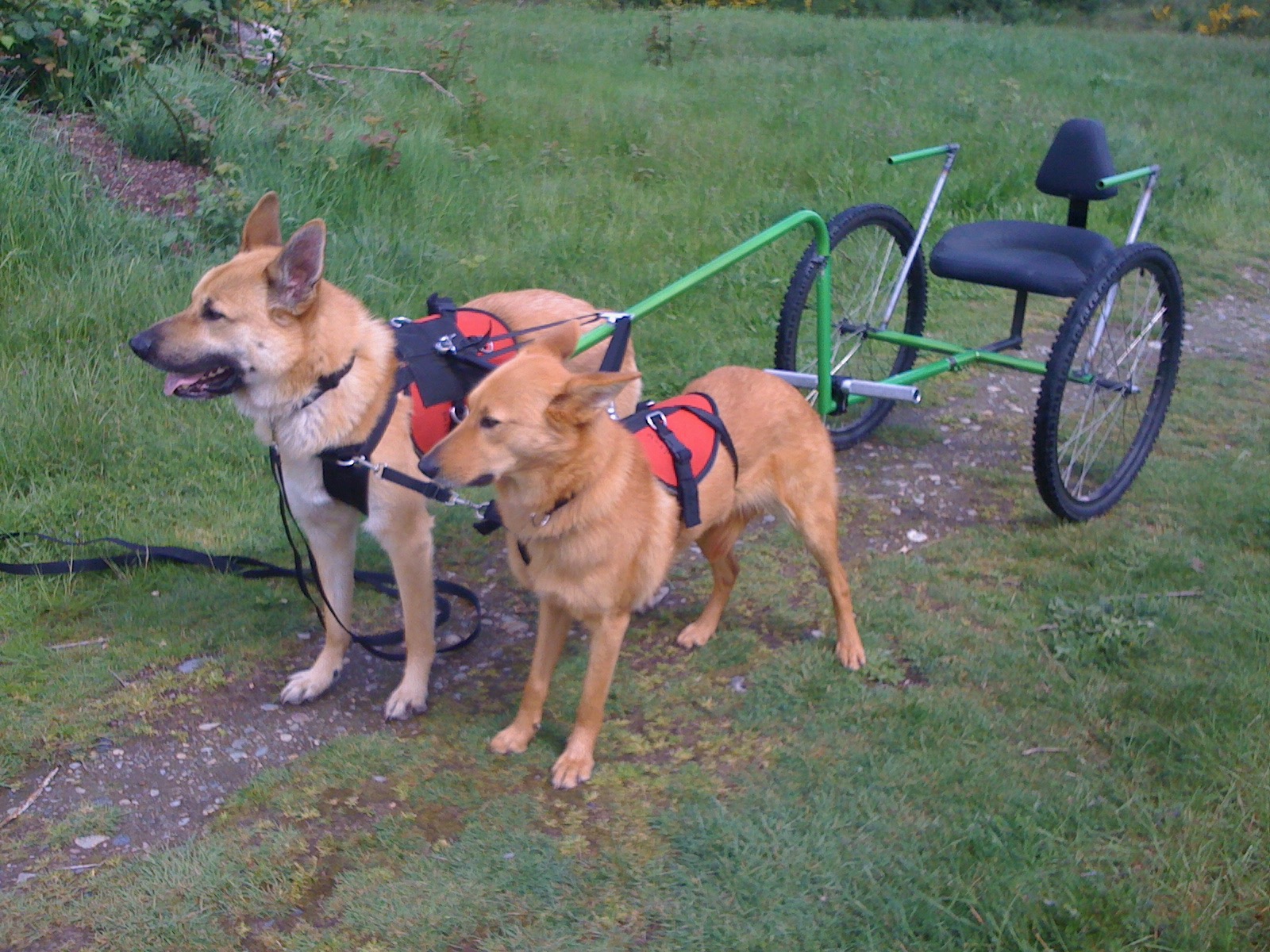
I had forgotten this sulky until I searched my photos to write this page. It was built in 2010. I see it as a logical, low-cost sulky. Feel free to copy it! It was built when I lived in Federal Way, south of Seattle WA. It weighs less than the suspension sulkies. It is easier to build. The only bend required is the forward shaft. The shaft from axle to harness is stiffer than previous models because it is shorter. Less tubing makes it cheaper and lighter. The shaft doesn’t drop down below the frame like previous versions.
If I were building it again, I’d lower the seat and arm rests. To hold the footrest, I’d use a longer handlebar stem and place it under the rear shaft, not on top.
The craftsmen who made my sulkies kept changing. Sometimes the men relocated; sometimes the shop manager pulled them off my jobs. Sometimes I relocated. When I sold one sulky, I used the money to make the next one. There was never a profit; my goal was to create the sport of dog driving. Dog Driving gives dogs a job they love.
Dogs are Brett, the champion Chinook, and Rosy, his daughter. Brett is confident. Rosy is timid. You can see their personalities in their expressions and stances.
Trail Dog
I loved hiking in the mountains near Seattle. I thought how great it would be to hike and not carry anything. I mounted bicycle panniers on a simple frame. When going up the trail, attach your leash to the back of the TrailDog. Tell the dog “Walk On”. Let him help you go up the trail. Dog power assisted hiking! When going down the trail, attach the leash to his collar. Do not let him pull you when going down hill! You would destroy your knees.
I sold one TrailDog. Gave up building them since they did not sell.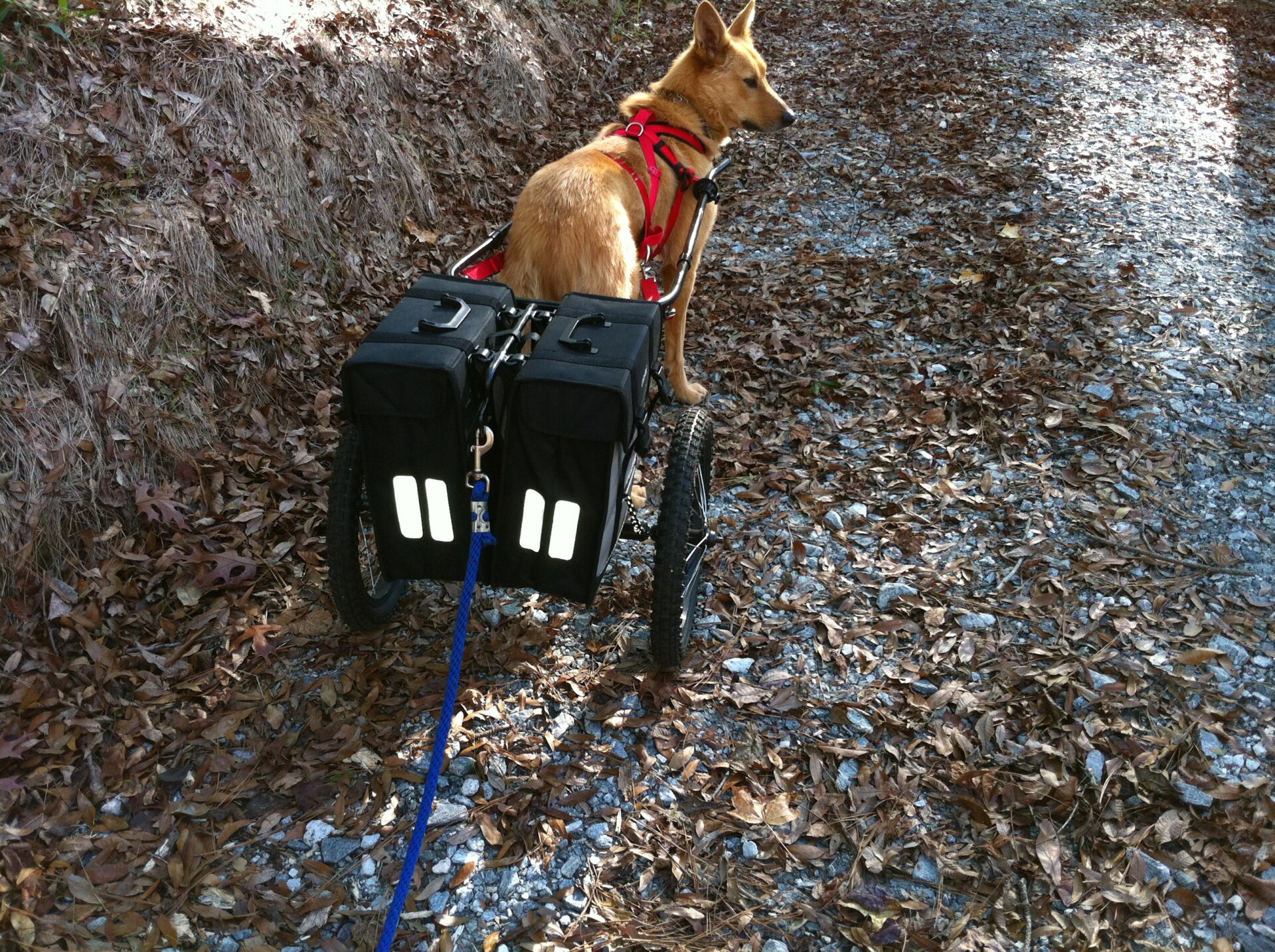 In above photo, Rosy walks in front and the leash snaps to a ring in the back. Nice looking panniers!!!
In above photo, Rosy walks in front and the leash snaps to a ring in the back. Nice looking panniers!!!

The frame is simple to build. Feel free to copy it. Photo shows the over-size sulky harness that we had at the time. Our recent harnesses are less bulky and more comfortable. See recent harness on Tug, the smooth collie, in photo below.
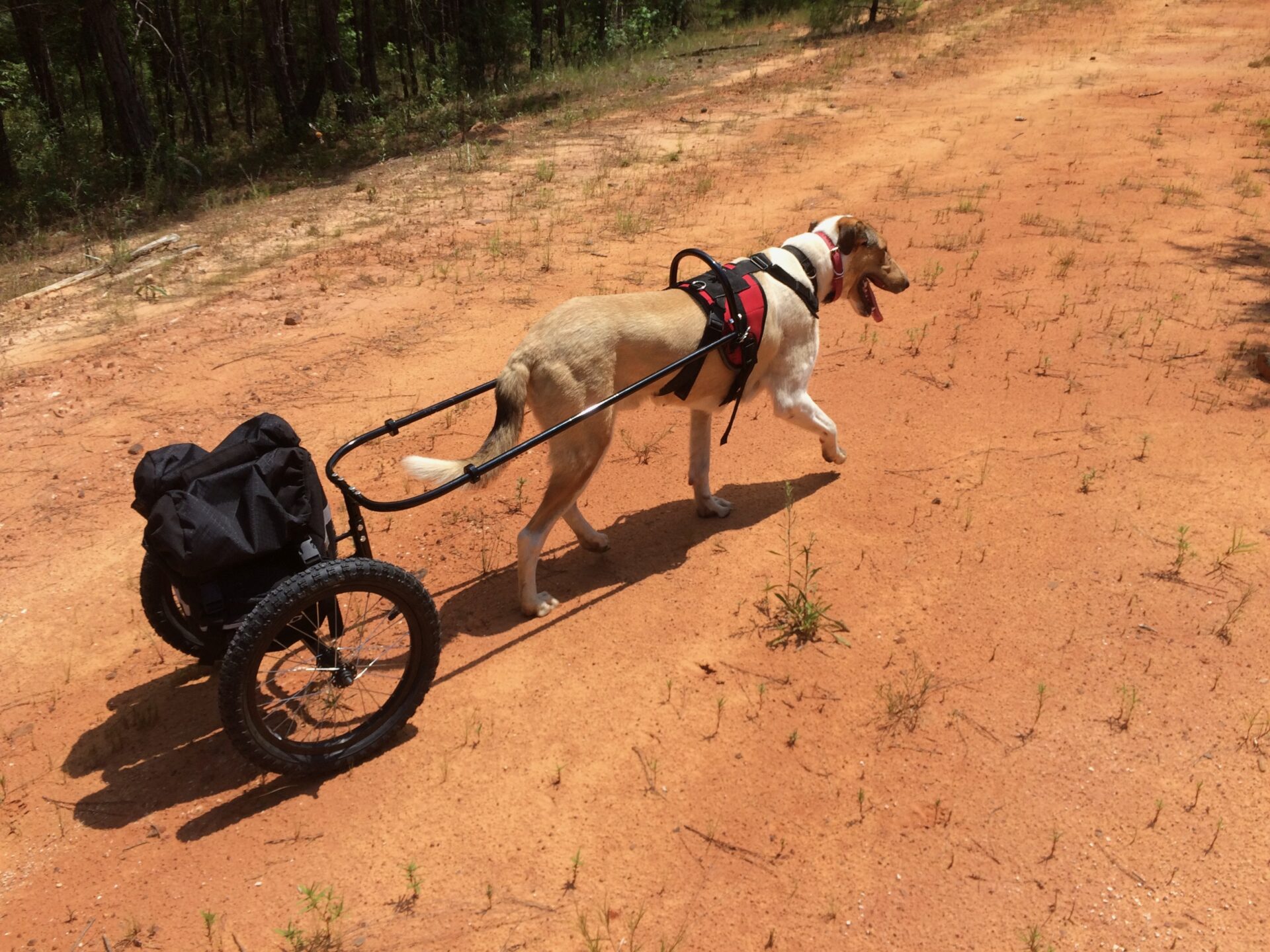
Tug in the photo above pulls the TrailDog on red Georgia dirt in our current harness. We used more casual panniers in this photo. The shafts are too long. Just need to be long enough that the dog’s foot does not hit the frame.
Easier-to-Build Suspension Sulky

This sulky uses the suspension fork as it arrives from the warehouse with its built-in fork crown. (It is easier to use the fork without modifying it.) Therefore the sulky has a two-hole aluminum fork crown. The fork crown is higher than the one Chalo Colina made with three holes.
With this suspension sulky, the forward shaft has an outside diameter small enough to slide into the rear shaft. It raises or lowers to accommodate the height of the dog. We used disc brakes instead of caliper brakes. We added a ring inside the bend of the forward shaft. The ring adds stiffness to the forward shaft and is useful for attaching tug-lines. Tug lines attached to the ring keep faster dogs from surging in front of slower dogs. The two dogs remain evenly abreast.
The Hawkinsville Simple Sulky
I moved to Hawkinsville, Georgia, in September 2014. I built a garage and Steven Dawcet began building my sulkies. I wanted a bare-bones sulky. We did not have a tube bender so no curves were possible. We ran the rear shaft directly to the frame that holds the seat. There is no steel triangle hanging down to hold the rear shaft. (The brake handle did have a bend; it was made of conduit tubing which bends easily.)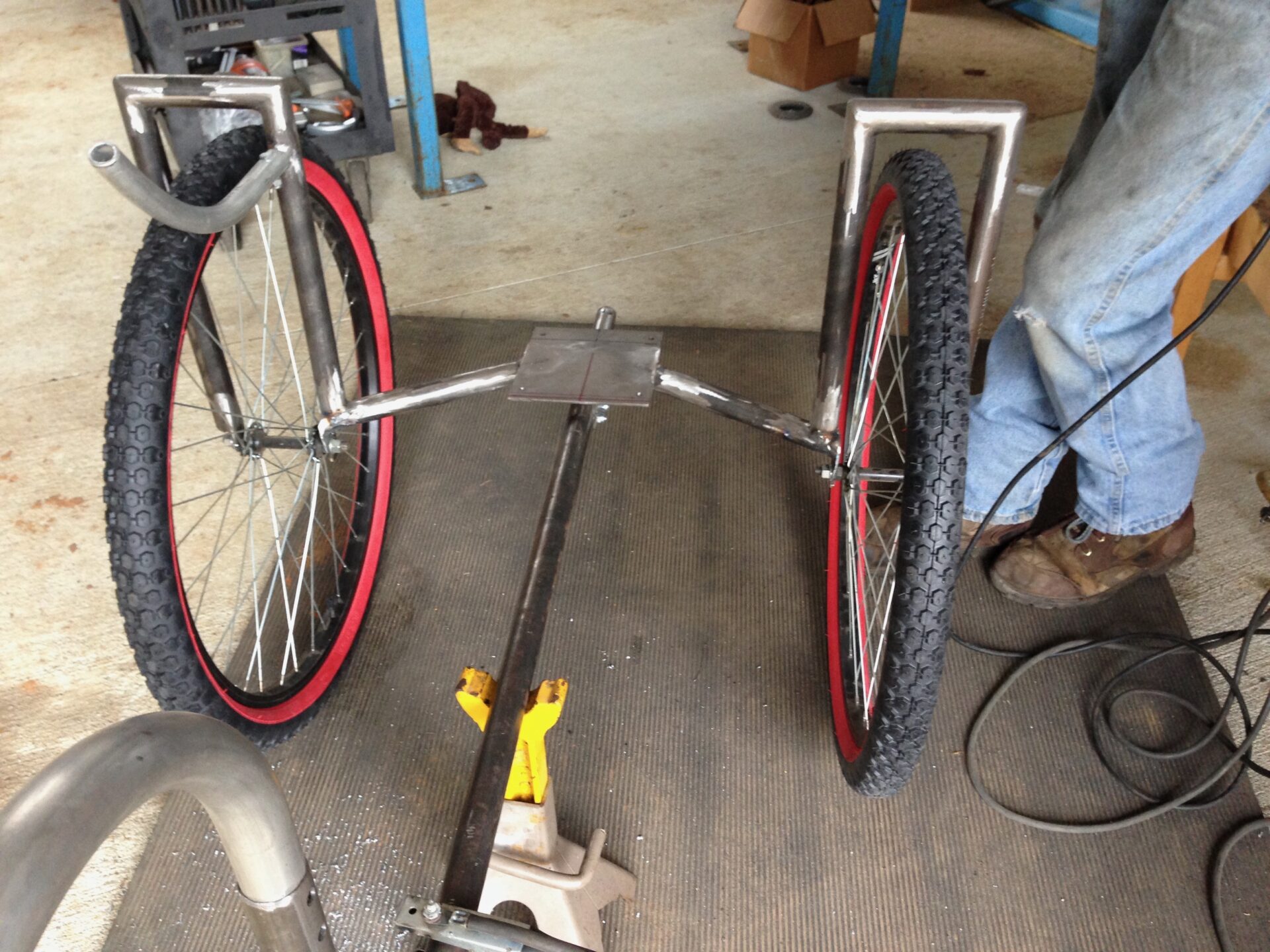
Steven and I tried other designs as well. Below is a sulky with regular bicycle fork instead of suspension and a two-hole fork crown. Only made one of those! Machined aluminum fork crowns are expensive!.
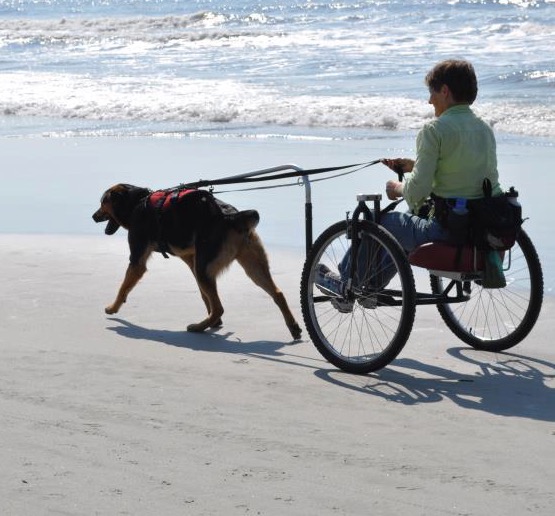
Rosco, a Rottweiler X German shepherd, pulls me on a Georgia beach. Rosco was an ideal breed for pulling sulkies. Sadly, he and Rosy, the Chinook, got loose while boarding in rural GA. They chased livestock and were shot and buried where they were shot.
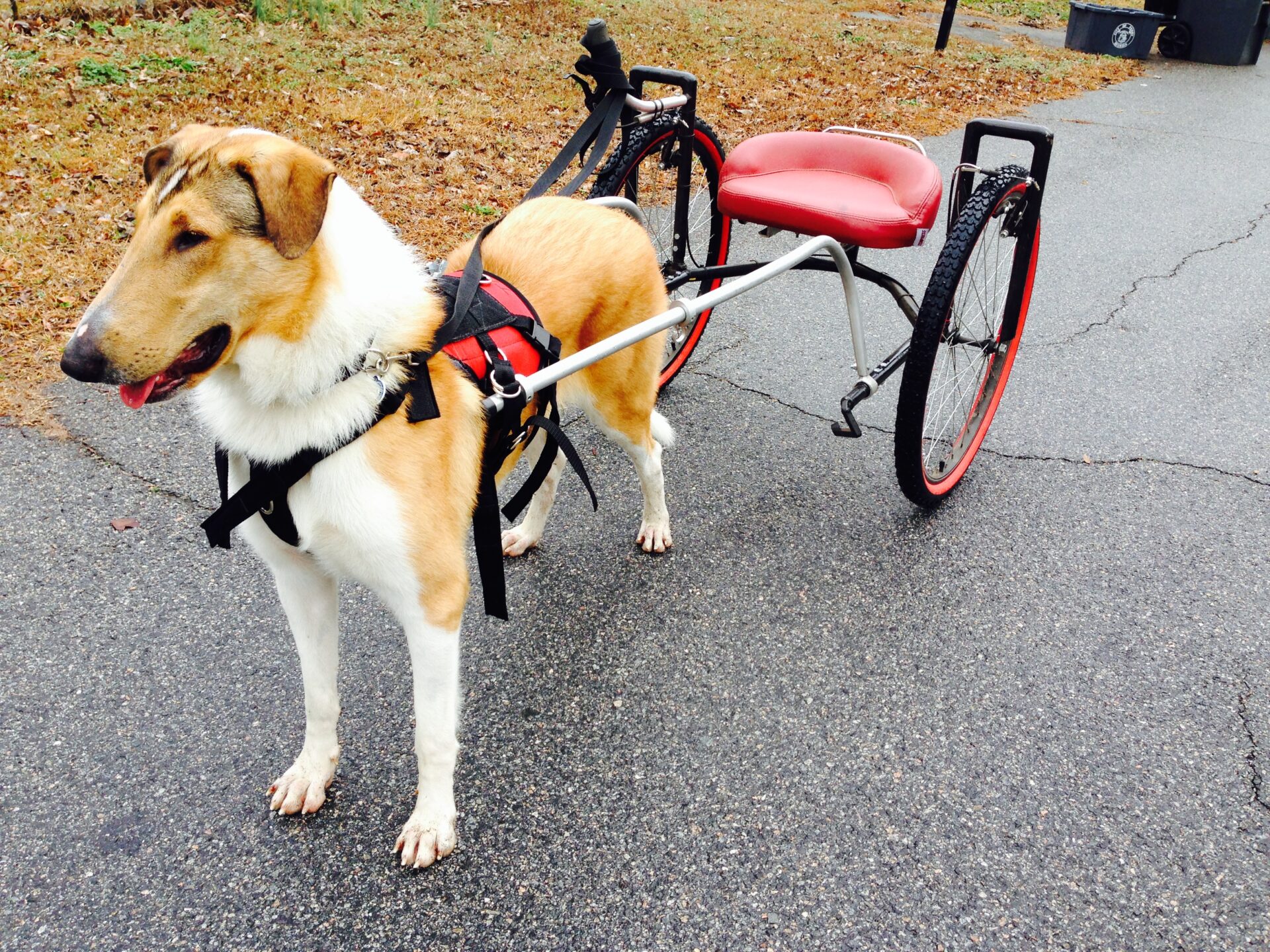
Stephen and I even built a side shaft sulky. Sold one; kept one. I might use it with my goats. The advantage of the side shaft sulky is that the shafts do not need to be strong. Conduit works great. Doesn’t need to be painted either.
Boone Hois in Illinois made sulkies for me after Stephen Dossett. The photo below shows me riding Boone’s version of the suspension sulky. Cross country with four dogs! We are about to enter a winter pond that is 6 inches deep and cross to the other side.
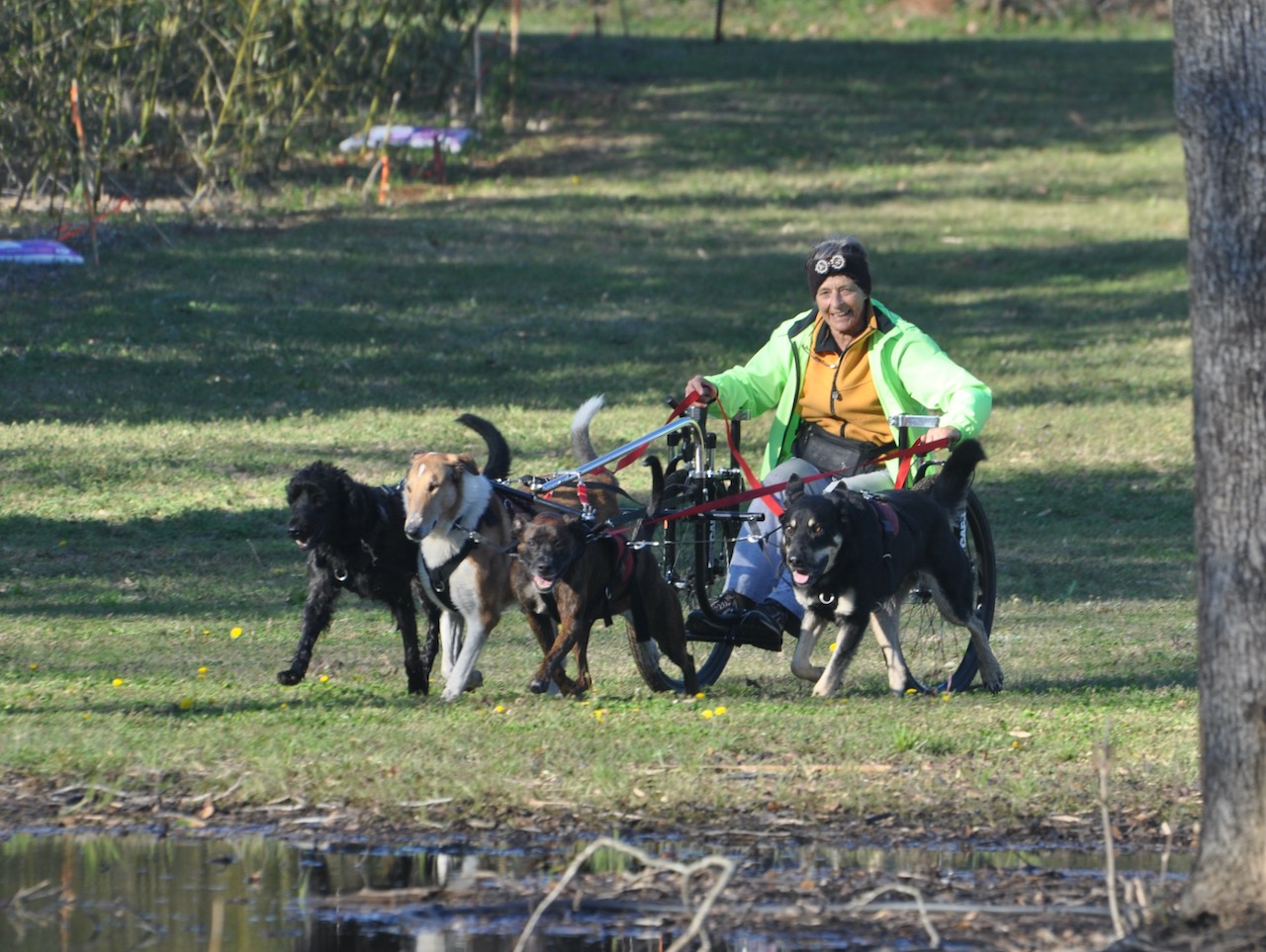
Boone Hois builds his own sulkies these days in his shop in Blue Mound Illinois. Boone is a member of International Association of Dog Drivers. He is an advocate of the sport of driving dogs.
Gina Hunter has supported me and the sport of dog driving since 2013. She believes that the sport of dog pulling saves dogs. Gina rehabilitates dogs for rescue organizations. The dogs live in her house with her calm healthy dogs. They learn from her dogs. Teaching them to pull a sulky gives them exercise, brain food and confidence. Photo with cart was taken in 2013 when Gina’s husky Loki modeled a wooden cart I built. Can the sulky harness be used with a two-shaft cart? With shaft loops that snap onto the O-rings, yes. However, the rings would need to be made stronger because the traces also pull on the O-rings. In the photo the traces are lax. They need to be shortened.
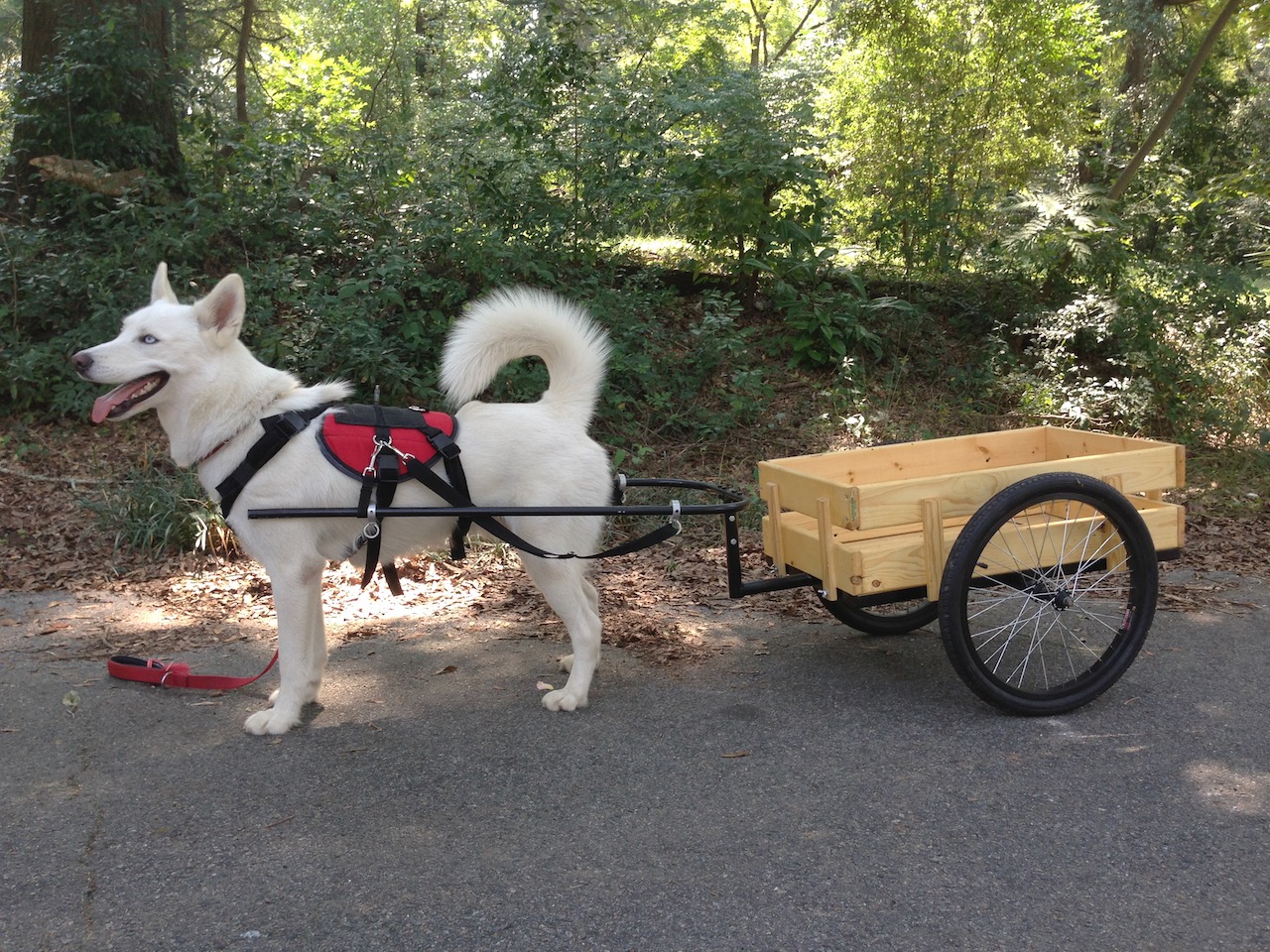
In photo below, Gina Hunter drives Loki who pulls a suspension sulky built by Boone Hois for Chalo Sulky.
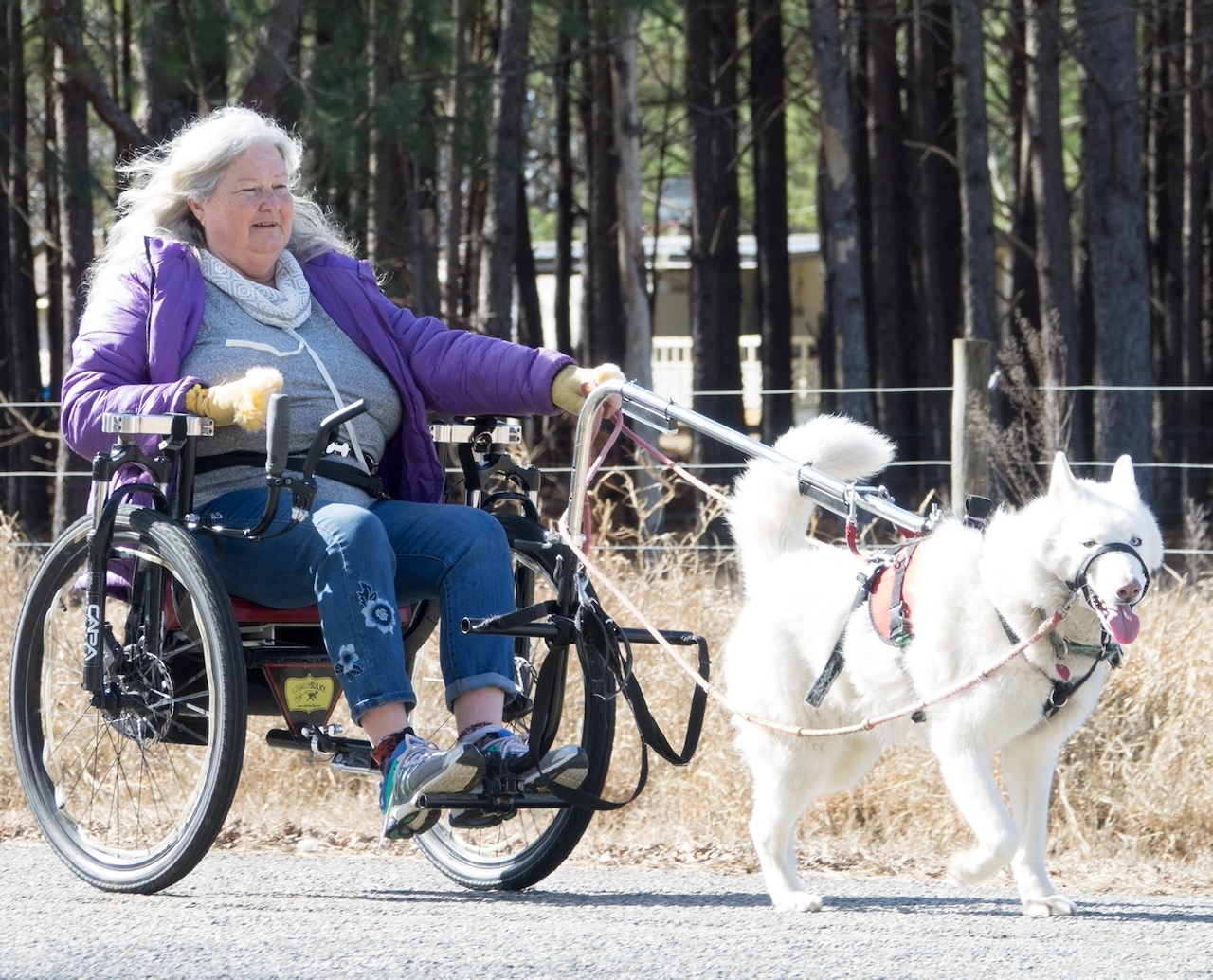
Gina Hunter specializes in teaching others how to train their dogs. Photo below shows Gina leading a student who walks behind his sulky in a ground training exercise at my bamboo farm in Hawkinsville.
Gina is a leader and backbone in the sport of dog driving. She is admin on multiple working dog groups and is the president of International Association of Dog Drivers. She maintains contacts with dog people in the United States and abroad.
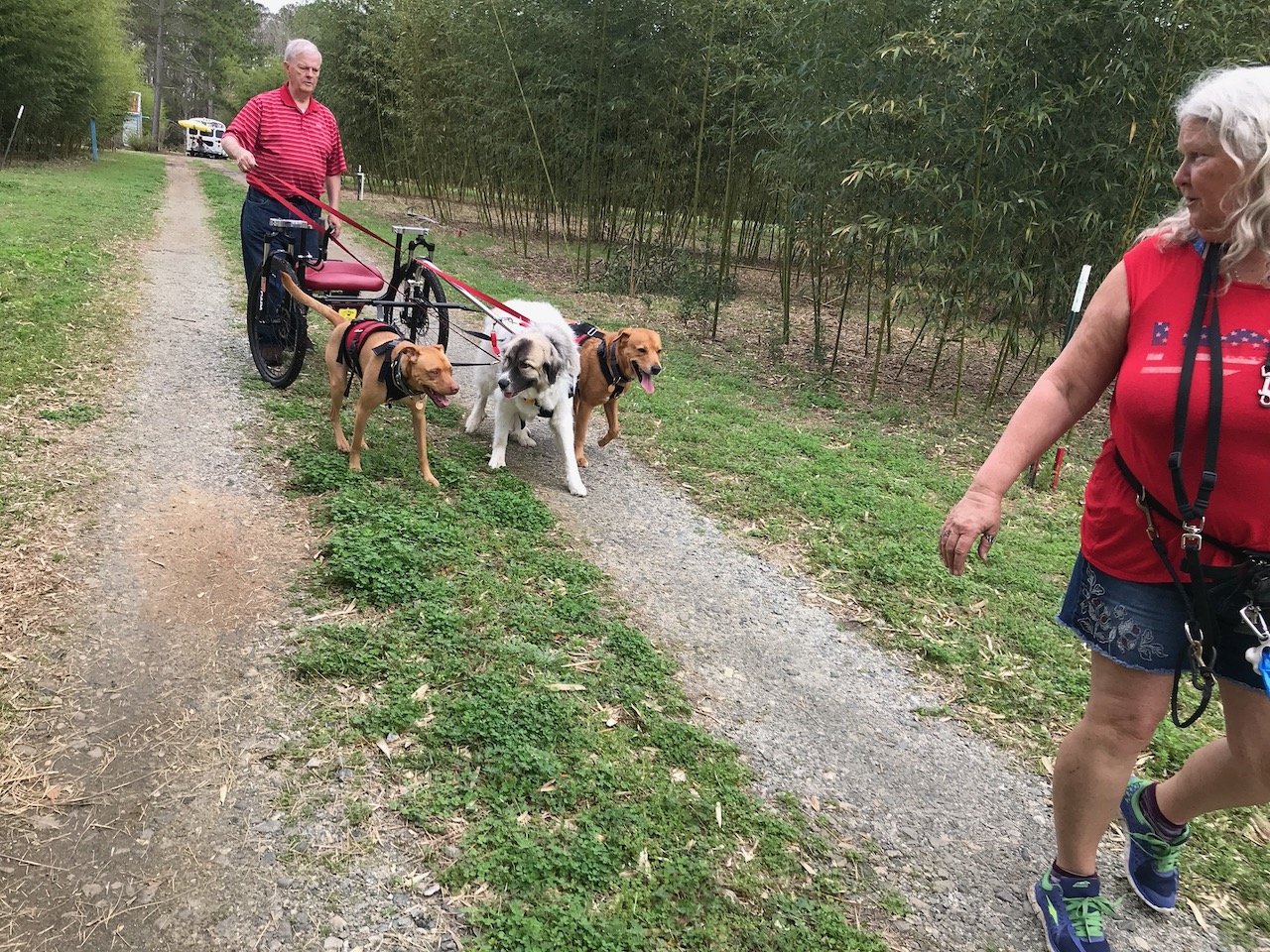
Bamboo Sulky
I worked with Tri Pham Minh of Viet Bamboo Bike to build a bamboo sulky. The first bamboo sulky arrived in August, 2016. Stephen Dossett put it together.
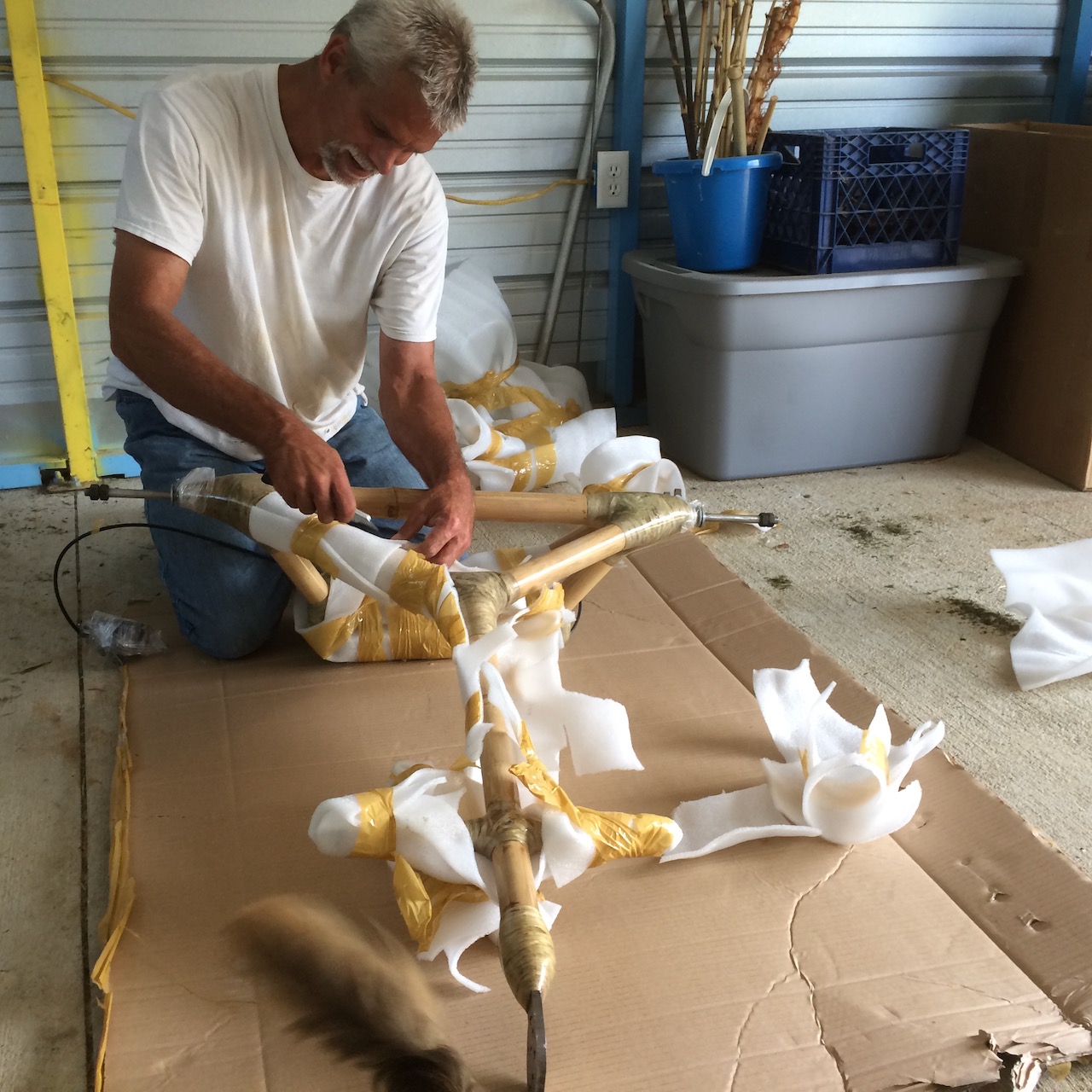
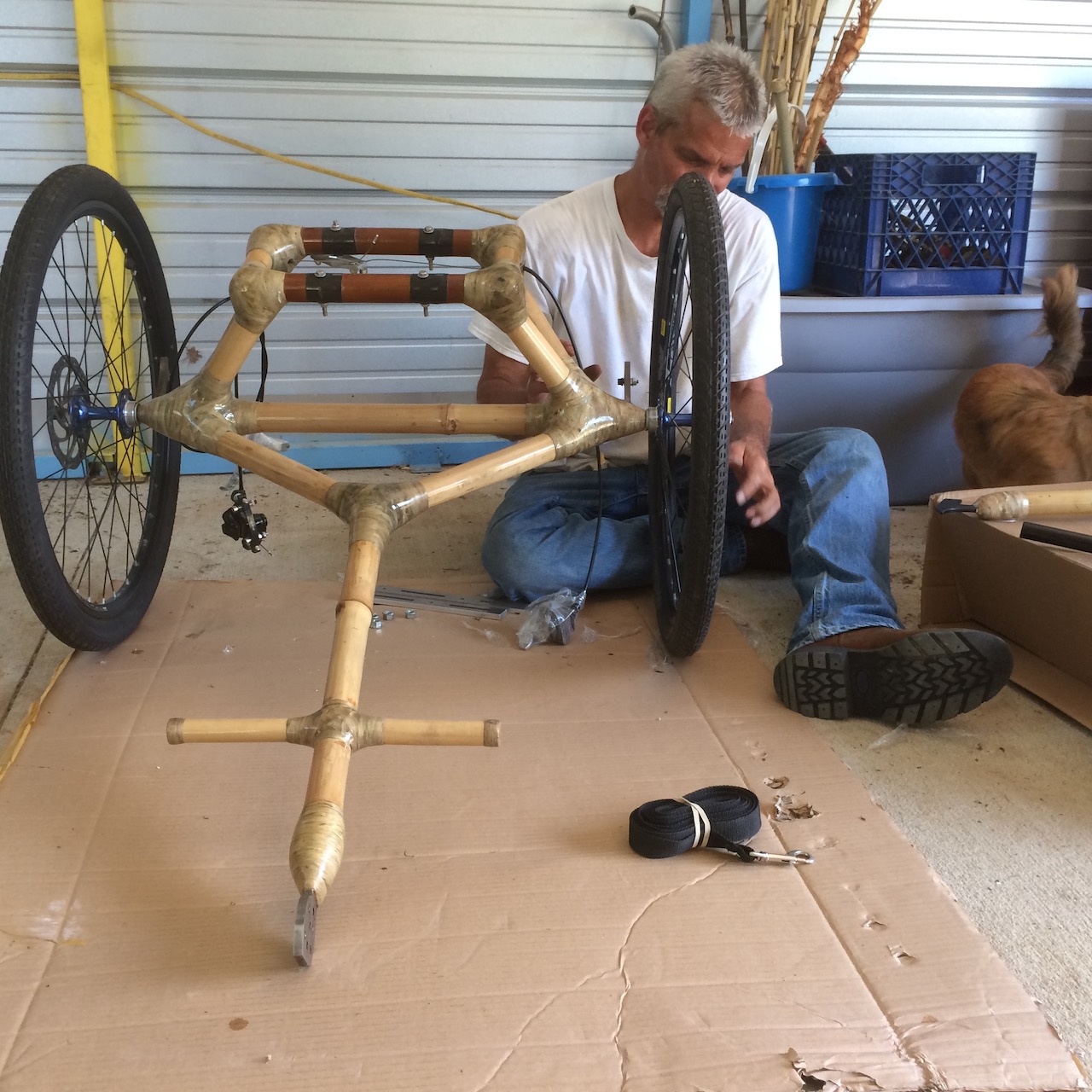
I dreamed of scrapping metal sulkies and selling only bamboo sulkies. This first bamboo was amazingly strong and light weight. My collie Tug, my shepherd mix Houzeau and my poodle mix Shaggy pulled the bamboo sulky. And then along came Petey the adorable and Tuxedo the black pitbull.
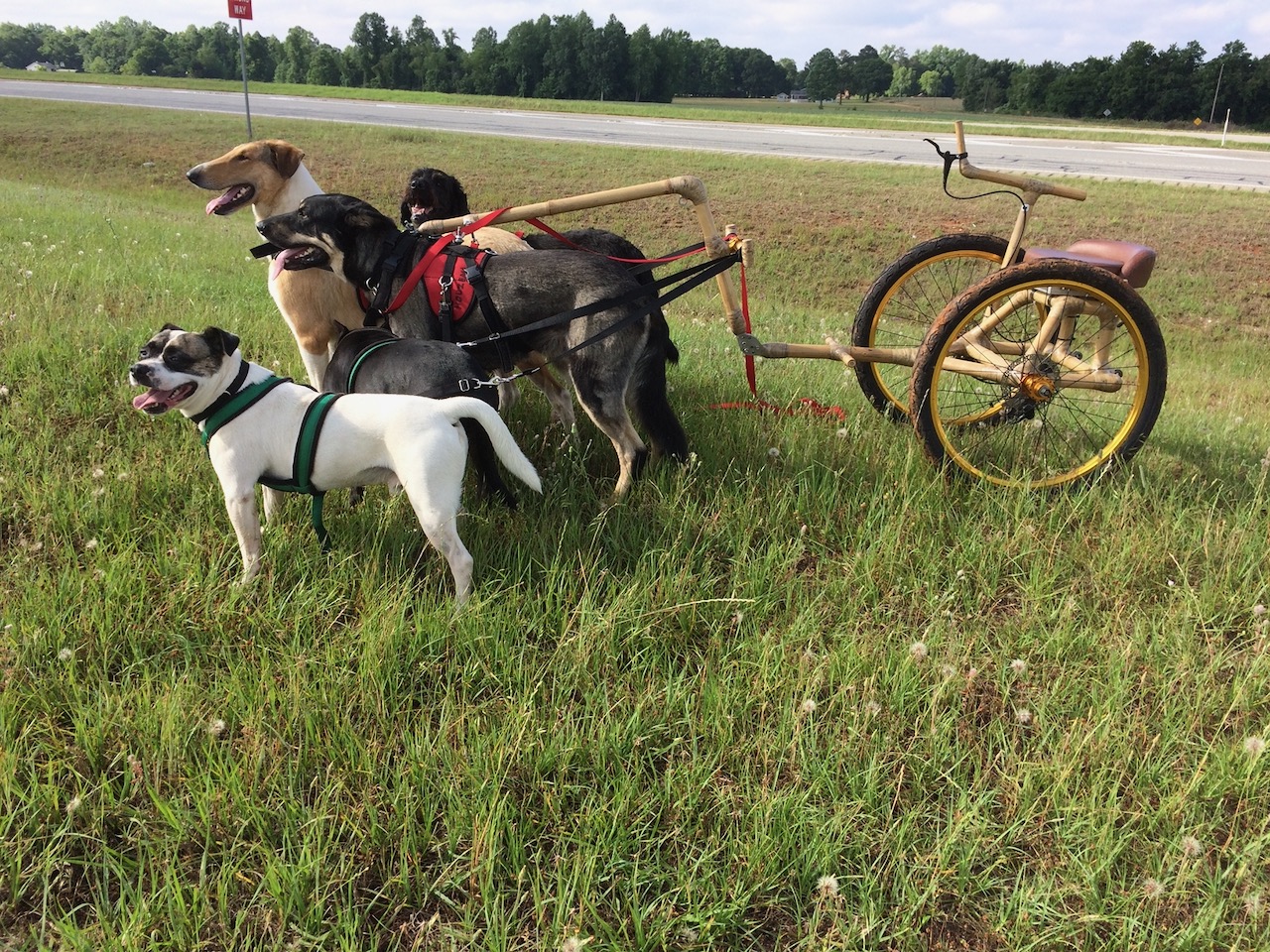
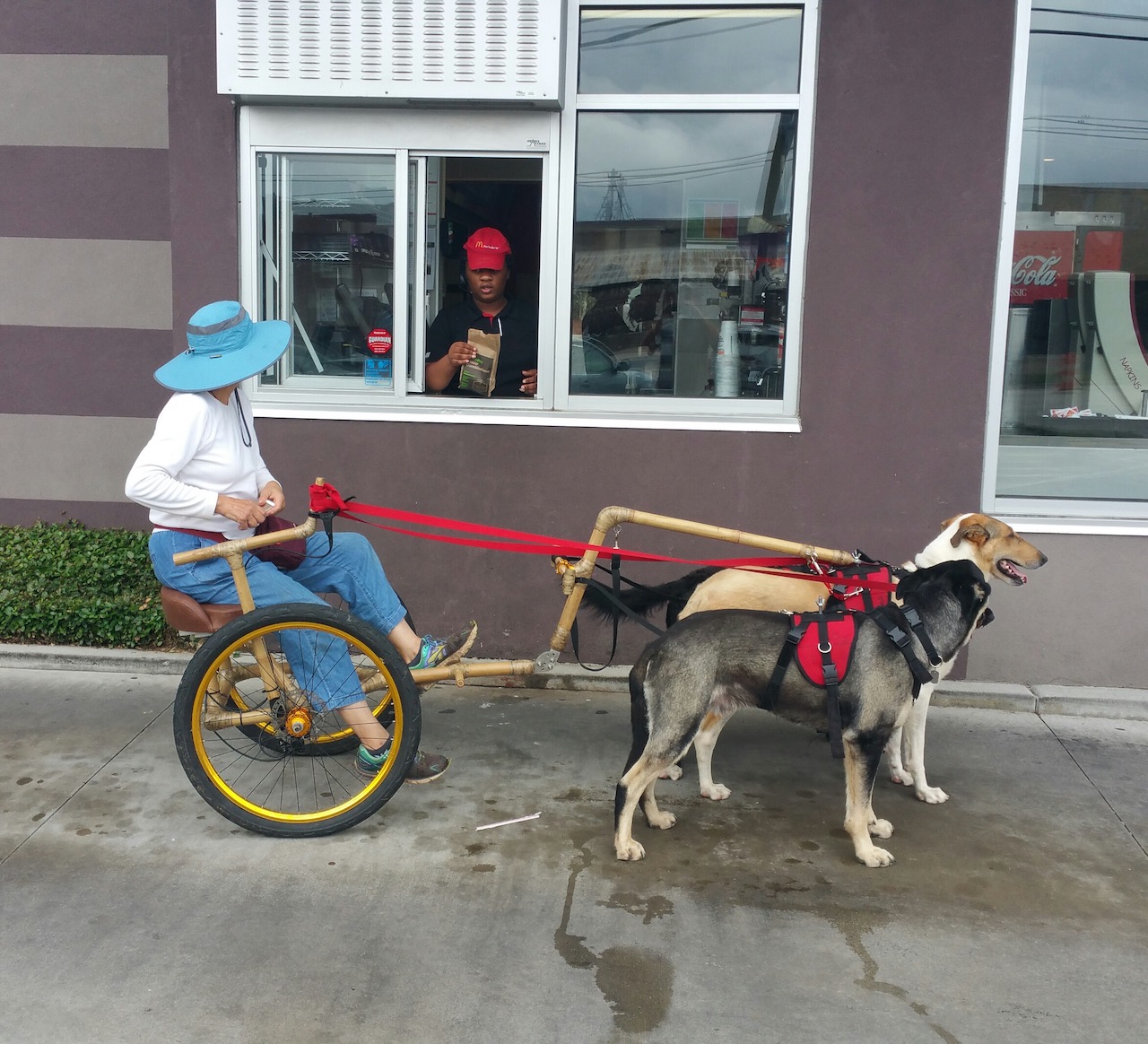
I’ve gone through the McDonald’s drive-thru a couple of times. The first was with my bamboo sulky pulled by Shaggy, Tug, and Houzeau. We ordered sausage, no bun.
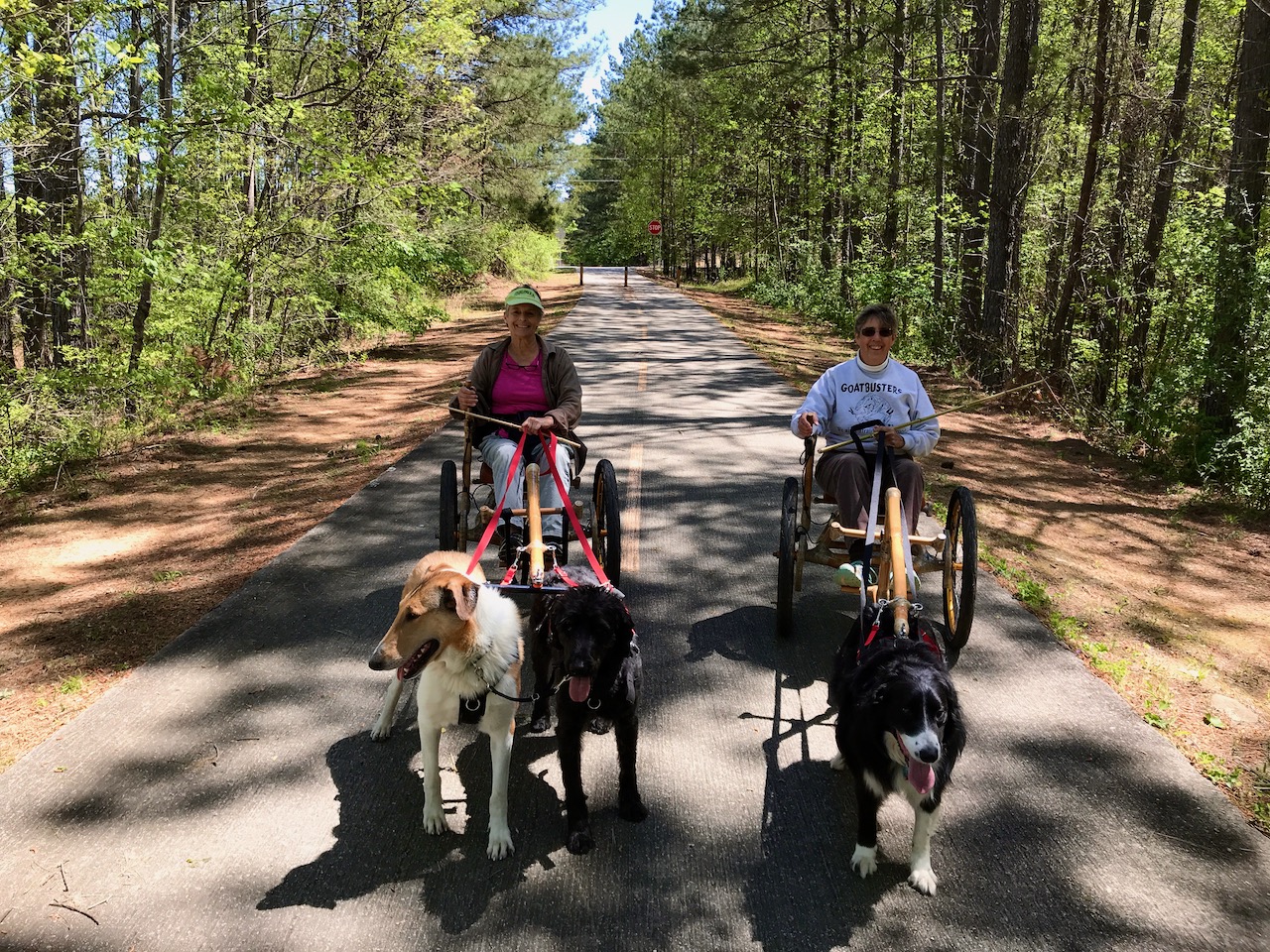
My friend Marie Harsh and I rode together on our new bamboo sulkies. Her one dog was faster than my two dogs.
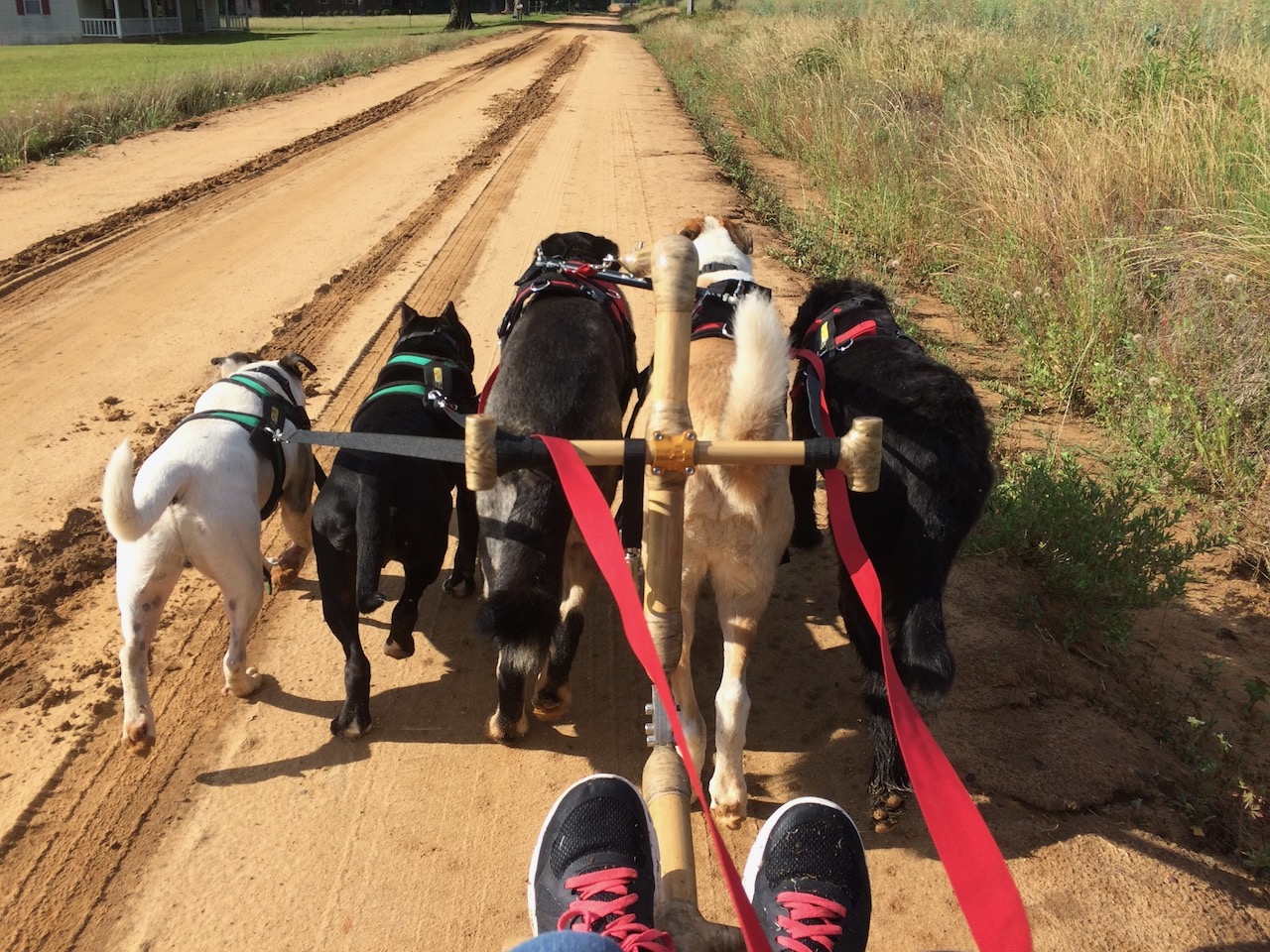
Photo shows the two little pitbulls working with the big dogs. Video below shows the two of them pulling by themselves. I can’t recall training them individually, so I think they learned from being hitched with the big dogs.
I imported bamboo sulkies three times. Each new version was better than the previous one. In this photo of the third version, the lower seat and sturdier brake holder were the main differences. The low profile makes it look sporty to me. This version was almost perfect. Sadly, the cost to import the sulky was too great. My preference would have been to drop the steel sulkies altogether and sell only bamboo. If someone would fund me, I’d start up again with the bamboo sulky.
The bamboo is a unique bamboo native to Vietnam named Tam Vong. It is thick walled, even sometimes solid. They call it iron bamboo because it is so strong. Bamboo’s density changes from outside walls to center of the pole. This change dampens vibration and shock. Steel has one density and shock waves move easily through it.
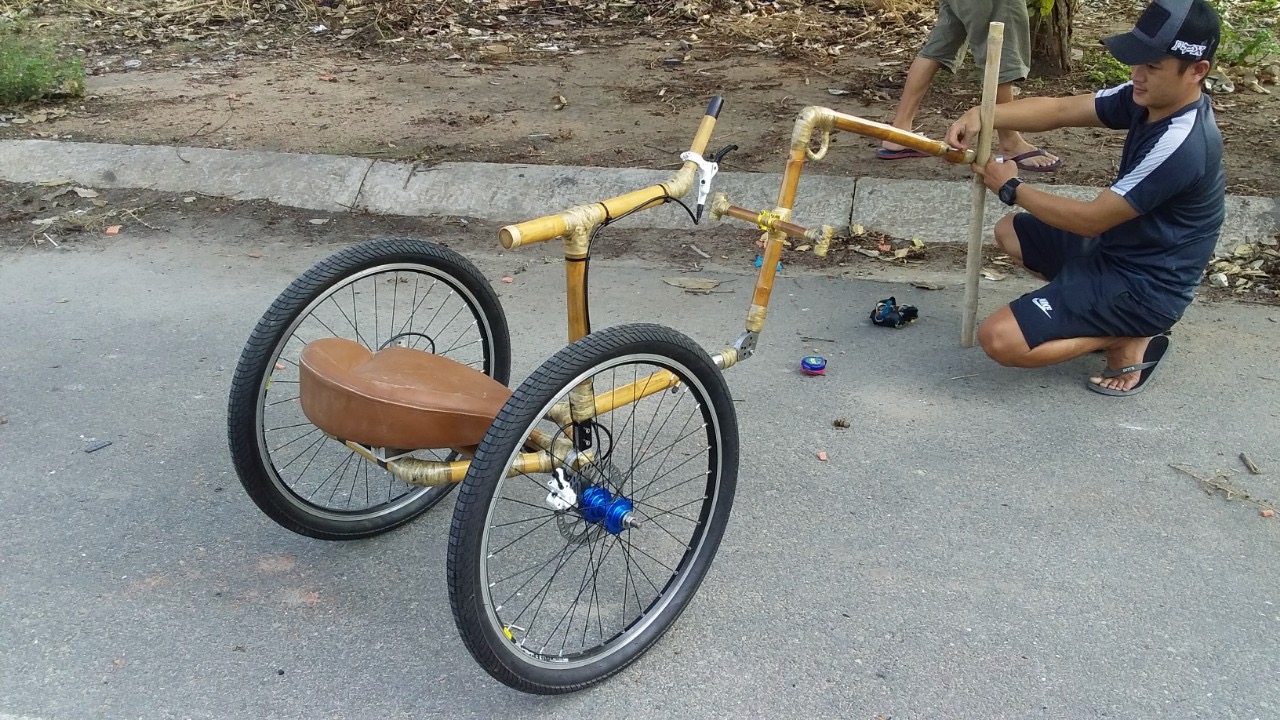
The Al Kimbell Simple Sulky
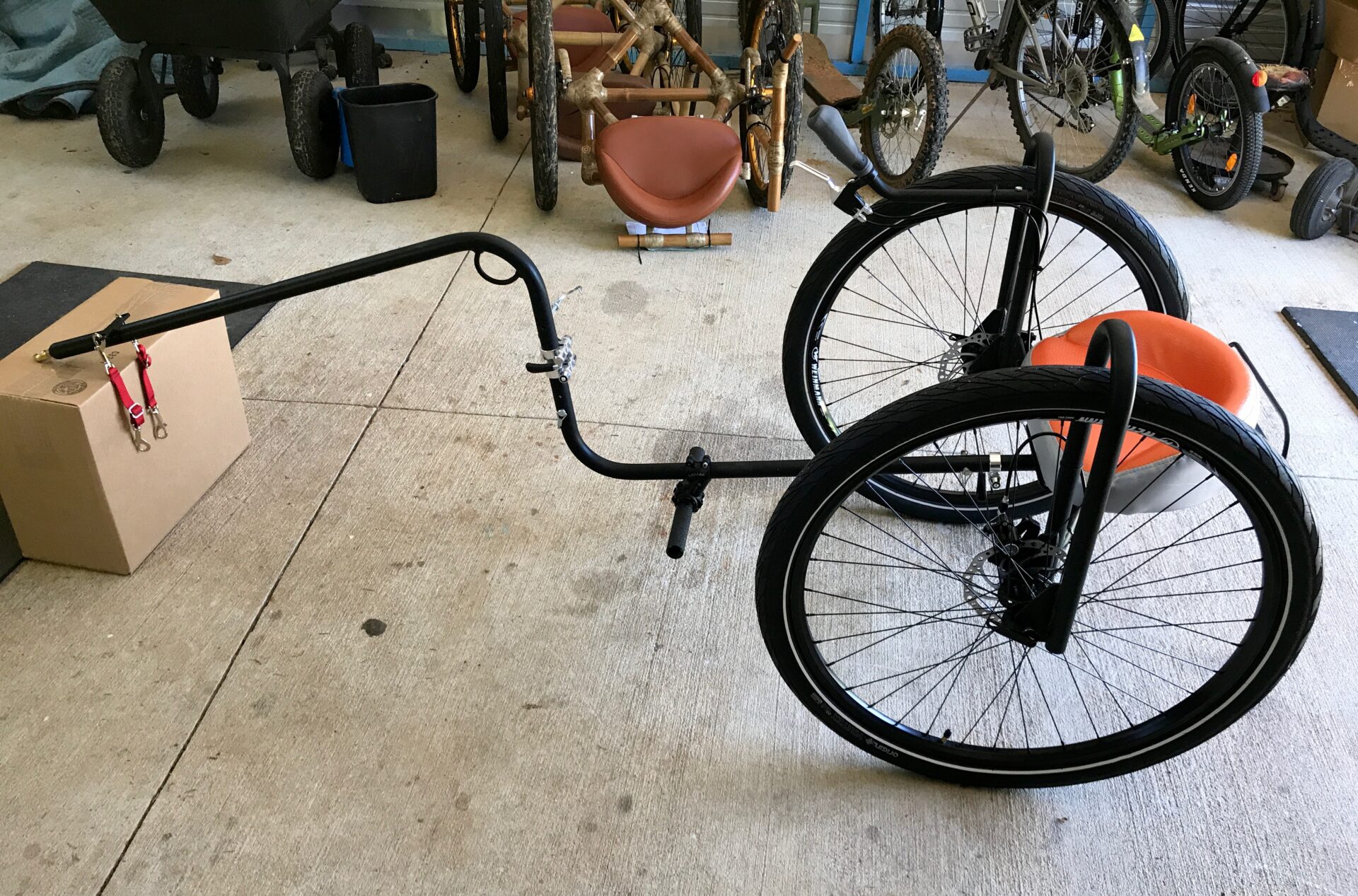
Al Kimbell improved both the simple and the suspension sulky. Al shortened and simplified the forward and rear shafts. The sulky is stiffer. Flexes less. Al’s sulkies are better looking than previous sulkies because of the simplified design.
In the above photo of Al’s simple sulkies, the seat sits behind the axle directly on the frame. The rear shaft couples directly to the frame, not to a drop down triangle. A standard bicycle “stem” attaches the foot rest to the rear shaft. It is long and angles forward. It allows the footrest to adjust for different lengths of leg. Adjustment for the height of the dog occurs at the junction of forward shaft and rear shaft. Brakes are disc brakes.
The forks are bent from mild steel. The frame and shafts are chromoly (bicycle) steel. The luggage rack slides with the seat. It can carry water. Mostly we added it so that the sulky can be stored in a garage on its back without damaging the vinyl seat.
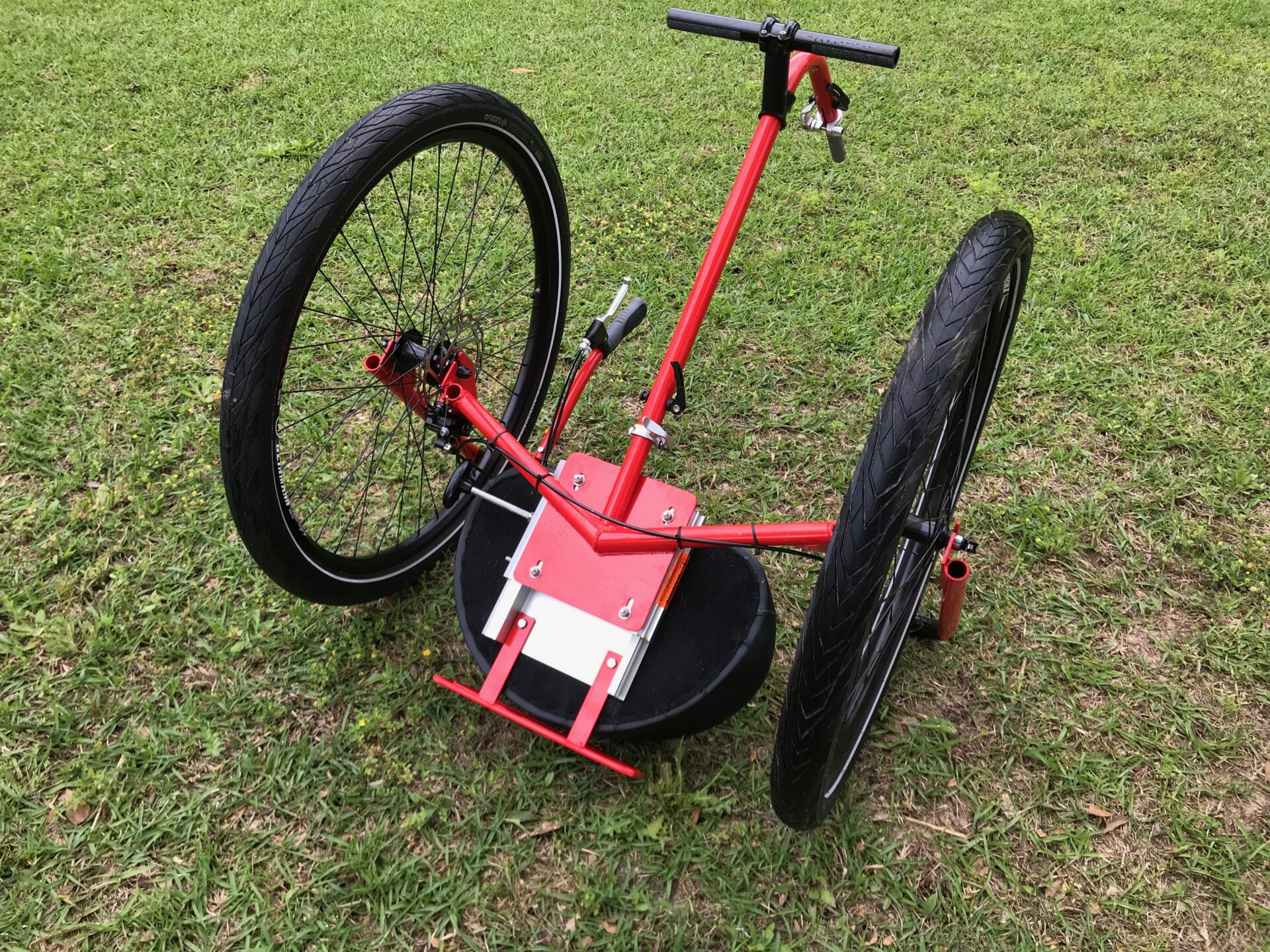
We use quick release levers between rear shaft and frame, between forward and rear shafts, and to remove wheels. People easily disassemble the sulky to put it into the car. They also add to the cost of building the sulky.
I like the simplicity of the design of the simple sulky. It is narrow enough to fit through most doorways and to dodge around pedestrians on sidewalks.  Sadly, this sulky is too expensive to build. I discontinued it, August 2023.
Sadly, this sulky is too expensive to build. I discontinued it, August 2023.
Were I to build the simple sulky again, I would change the angle of the bends of the shafts. The purpose would be to reduce the amount of tubing and improve the aesthetics. Less tubing means less weight and less cost. Instead of bending upwards at a right angle, the rear shaft would bend forward slightly. The photo of James Walsh and his famous giant schnauzer Tom shows the ideal shaft angles. Walsh’s angles reduce the amount of tubing used while still protecting the dog’s rear legs from hitting the shaft. The shorter the tubing, the stiffer the shafts.
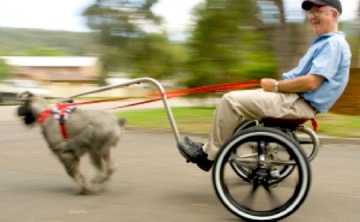
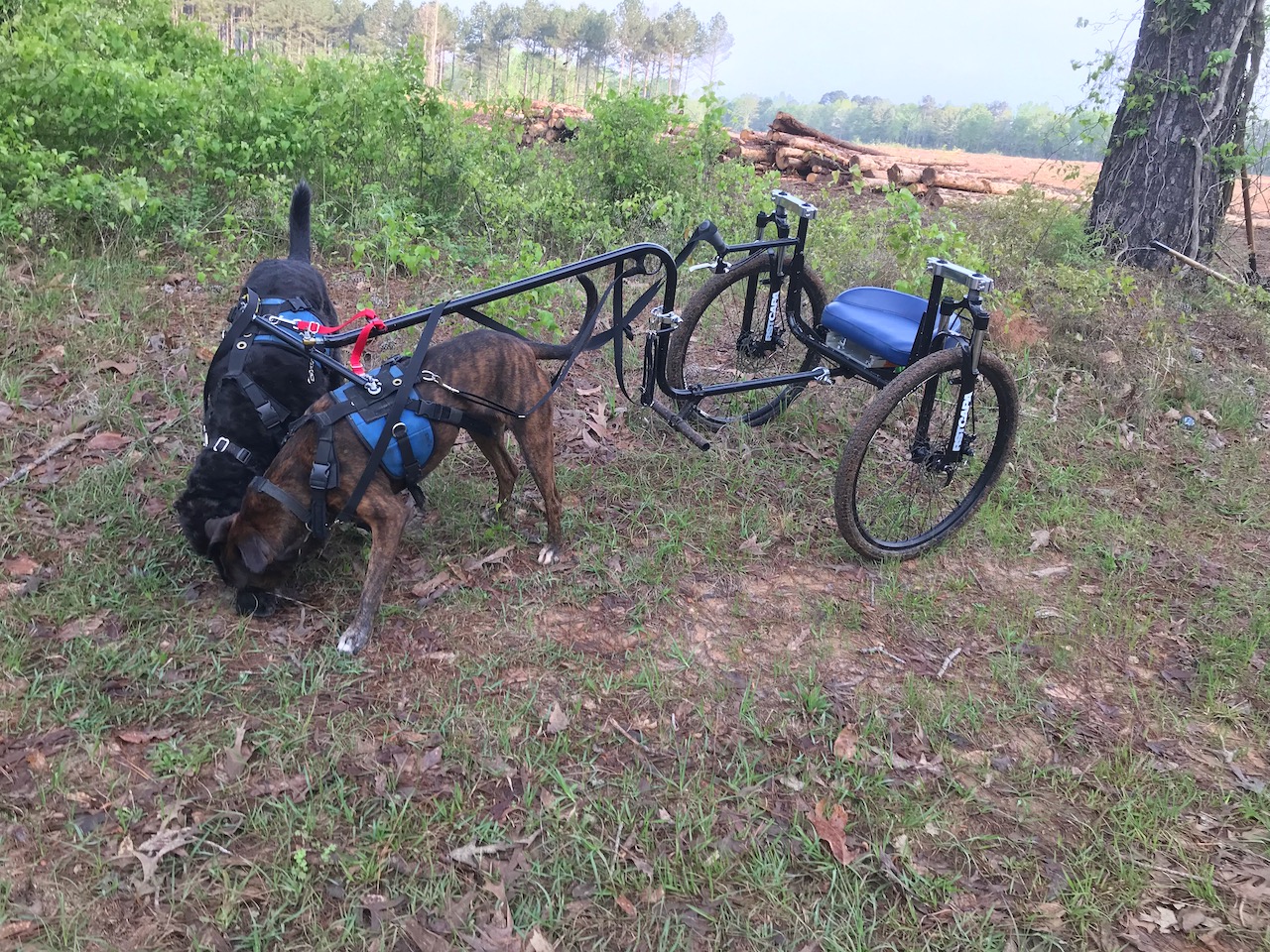
Al’s final suspension sulky had a reinforced frame. Stiff at last! It is the right machine for two, three or four fast dogs on rough ground.
Like the simple sulky, I discontinued making it in August 2023.
